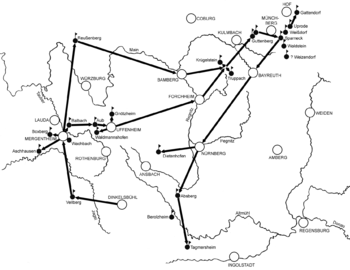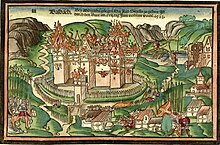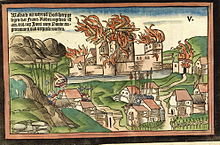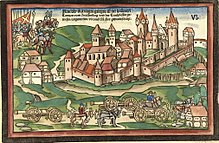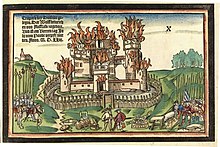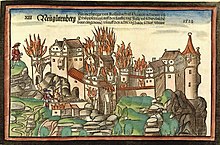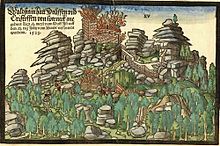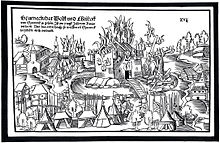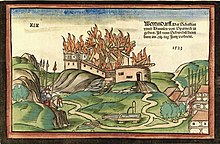Wandering woodcuts from 1523



The Wandereisen woodcuts from 1523 include 23 woodcuts by war correspondent Hans Wandereisen . In 1523, troops clearly superior in strength (10,000 soldiers and 1,000 horsemen with 100 rifles , 22 cannons and 900 pounds of black powder ) of the Swabian Confederation , which consisted of Franconian and Swabian imperial estates , destroyed a total of 23 so-called predatory nests , whose owners were Hans Thomas von Absberg had helped kidnap and extort ransom from mainly Nuremberg and Augsburg merchants to imperial diplomats. Georg Truchsess von Waldburg-Zeil was Commander-in-Chief of the Swabian Federation, the captain of the mounted troops was Rudolf von Ehingen and the captain of the infantry Jakob von Wernau . In order to tell ordinary people, who mostly couldn't read, about the successes, Hans Wandereisen traveled with him and made woodcuts of the burning castles.
These are important for local history research today, as they show the state of the castles before some were blown up to prevent the owners from returning. The events are also referred to as part of the Franconian War or the Absberg feud .
The woodcuts are known in three versions. Compiled as a castle book, they are now kept in the Germanic National Museum in Nuremberg . There are also unpainted woodcuts in the Germanisches Nationalmuseum (shown at 2, 14-18). The subsequently colored woodcuts shown here are part of a castle book of the Bamberg State Library . The castle book in Bamberg was probably created a few years after 1523. The lettering of the monochrome and the colored woodcuts differ in smaller details, such as the spelling.
List of woodcuts from 1523
The following list shows the stations of the train of the Swabian Federation. Despite a few chronological inconsistencies in the process, the order of the images was retained according to their original labeling.
The army of the Swabian Confederation, under the command of Georg Truchseß von Waldburg , took up position in Dinkelsbühl at the beginning of June 1523 and marched, so that it reached Vellberg Castle (1) on June 11 and set up camp near Mergentheim . The following castles (2–8) are all in the south of Würzburg and were thus located in the knightly canton of Odenwald . Prince-Bishop of the Würzburg Monastery at this time was Konrad II von Thüngen , who also had to rely on federal aid during the Peasants' War . The destruction of the castles lasted from June 12th to June 24th. The army camped at Uffenheim on June 22nd and at Forchheim on June 24th . While a delegation was sent to blow up Reussenburg near Bonnland on June 26th, the main army moved on through the Bamberg region under Prince-Bishop Weigand von Redwitz and camped near Haßfurt on June 28th .
On July 1, Truppach and Krögelstein (10, 11) in Franconian Switzerland (located in the knightly canton of Gebürg ) were captured and set on fire a few days later. On July 2, the army moved into quarters at neighboring Hollfeld . A smoldering conflict with bailiff Konrad Schott von Schottenstein at Streitberg Castle near Streitberg did not escalate. On July 7th, the army camped near Marktleugast and burned down the two castles Alt- and Neuguttenberg (12, 13) the following day. A delegation that had set up camp in Sparneck destroyed Gattendorf Castle (16) on July 10 , while all other Sparneck castles close to one another were destroyed by July 12 (14, 15, 17, 18, 19?). Another seat of the Sparnecker, Stockenroth Castle , had already burned down and for this reason only did not become a federal target. The aristocratic seat of the Wirsbergers in Glashütten was not attacked, although Hans Thomas von Absberg had followers there too. Nordeck Castle , the seat of the Bamberg bailiff Jörg von Wildenstein , was also not attacked , although the Nuremberg merchant Balthasar Baumgartner was held prisoner there in 1522. The castle was finally destroyed three years later in the Peasants' War.
Contrary to the policy of his predecessors, who like Albrecht I Achilles promoted predatory attacks by his vassals against merchants in the more opportunistic imperial city of Nuremberg , Margrave Casimir from the Hohenzollern family took a more neutral position. The necessity of securing one's own territory is shown in the maintenance order of 1498 . Casimir himself had been a captain of the league in the past. When it became apparent that Nuremberg's interests were being enforced in the fifth unification period , Casimir did not renew his membership in the Bund in 1522. Various knights attacked or threatened wrote to the Duke of Saxony Johann , but he did not intervene in the conflict. Initially, the federal government feared interference by the Schweinfurt unification nobility or by the exiled Duke Ulrich von Württemberg , but the systematic campaign against the knights' seats never met with any noteworthy resistance. In view of the overwhelming odds, all of the knights wanted for the raids had fled.
On July 17th, the army finally reached Nuremberg and marched through the city in a victory parade. About half of the army had previously been disbanded. A further shrinking troop moved against four more castles west and south of Nuremberg (20-23) in the knight canton of Altmühl by July 22nd . On July 25th the last Augsburg mercenaries reported back.
Vellberg Castle
| Woodcut | Transcript | Location and background | |||
|---|---|---|---|---|---|
| I. Velberg / ligt a meyl from Schwebischen Hall. Wilhalms thayl broke off from the colorful. 1523 • | The castle Vellberg near Schwäbisch Hall was a Ganerbenburg with the family for Vellberg . It was canceled on June 11th by a delegation to the Vellberg part. Wilhelm von Vellberg rebuilt it between 1543 and 1546. |
Boxberg Castle
| Woodcut | Transcript | Location and background | |||
|---|---|---|---|---|---|
| II. Bocksperg bey Lauda was part of hanns thoman / hans melchior / hans ulrich / all rosenberger / is on .XIIII. day Junj vom Bunt eingenome (n) / am .IV. tag v (er) bre (nn) t | The castle Boxberg (in Boxberg ) owned by the family of Rosenberg was occupied on June 14 and blown up a day later. The castle had already been destroyed in 1470 due to the raids of the Rosenbergs from Kurmainz , Kurpfalz and the Bishopric of Würzburg . It was then converted into a Palatinate fief. In the fight against the outlawed Melchior von Rosenberg in 1523, the property fell back to the Palatinate. After Albrecht von Rosenberg had again enforced his claims to Boxberg in 1547, the property was finally sold to the Palatinate in 1561. |
Lower Unterbalbach Castle
| Woodcut | Transcript | Location and background | |||
|---|---|---|---|---|---|
| III. Balbach Bey Morgatha / belonged to Rüd Sützelln / Is through the Bunt / on .XVII. day June was spent (s). 1523. | The Untere Burg Unterbalbach (in Unterbalbach ) owned by the von Sützel family was burned down on June 17th. Today almost nothing indicates this castle, only its location can be roughly traced. |
Aschhausen Castle
| Woodcut | Transcript | Location and background | |||
|---|---|---|---|---|---|
| IIII. Aschhausen at the otten forest / belongs to Hanns Jorgen vonn Aschhausen / is through the Schwebischen Bundt / on .XIIII. day June was taken and spent. 1523 | The castle Aschhausen (in Aschhausen ) owned by Hansjörg of Aschhausen was burned on 14 June. Only preserved the dungeon . In the 17th / 18th In the 17th century, the abbots of Schöntal built a hunting lodge on the site , which today belongs to the Counts of Zeppelin .
The woodcut shows the castle complex on fire. An inner wall, interspersed with defensive towers, follows an outer enclosure. Behind it are several buildings and two larger towers. Smaller buildings and upper floors are made of timber framing. A coat of arms can be seen on the main building above the door frame and a protruding entrance area. Parts of the troops of the Swabian Federation can be seen on the right and left of the picture. |
Wachbach Castle
| Woodcut | Transcript | Location and background | |||
|---|---|---|---|---|---|
| V. Wachbach / nit weyt vo (n) Bocksberg located / belonged to Franz Rüden / was on .XIIII. on the day of June was taken and sold by Pundt. | The castle Wachbach in Bad Mergentheim in the family Rüdt von Collenberg was burned on 14 June. The ruin was subsequently used as a quarry, so that today only moats and stone remains are evidence of the castle. Today's Wachbach Castle was built elsewhere at the end of the 16th century.
The burning Wachbach Castle, surrounded by a moat , is the central motif of the woodcut. The fire has progressed so far that heavy roof beams collapse in the main building . In addition to the main building, an auxiliary building can be seen. The castle wall is interspersed with tower-like buildings. A crenellated tower stands by the bridge that forms the entrance to the castle. There is another building on the opposite bank that protects the entrance. In the foreground of the picture you can see several buildings in the village, they are half-timbered buildings , and the detailed fence structures are also striking . Parts of the army of the Swabian Federation are shown hidden behind a building and behind a hill, which at first only attract attention because of their long-handled weapons. The Bundische flag is also shown. |
City of Aub
| Woodcut | Transcript | Location and background | |||
|---|---|---|---|---|---|
| VI. Aub near Kitzingen / is the half-dayl of Cuntzen vom Reussberg / and the Truchsessen was / eingenom (m) en / and umb M. flor. gepran (n) chats | The town of Aub , owned by the Rosenberg families and the Truchseß von Baldersheim families , was occupied on June 19 and sacked for 1000 guilders . The cityscape on the woodcut can still be seen today in many details of the city wall with its fortified turrets and other striking buildings. To this day, Aub has preserved a late medieval town center surrounded by a wall. |
Waldmannshofen Castle
| Woodcut | Transcript | Location and background | |||
|---|---|---|---|---|---|
| VII. Walmershoffen - Bey Awe located / has belonged to Kuntz vo (n) Rosenberg. Is on for .XXIII. day Junj of the colorful in-nome (n) un (d) spent • 1523 • | The castle Waldmannshofen (in Waldmannshofen ) owned by the family Rosenberg was burned on 23 June. Kunz von Rosenberg, who fled in time, began to rebuild the castle shortly afterwards. He was to a considerable extent dependent on the support of his subjects. The work lasted from 1544 to 1552.
The castle complex is shown as a massive structure that is not only secured by a moat , but also by an inner and an outer stone wall , which is interspersed with watchtowers on both sides . Another wall with another gatehouse is in front of the area in front of the gatehouse . This upstream area is also partially filled with water, so that you have to cross two bridges to enter the castle. The outer gatehouse has an additional half-timbered floor. The inner gatehouse bears the Rosenberg coat of arms above the archway . The entrance opposite the inner gatehouse leads into a first high building, to the right of it is the main house with two roof gables , which is connected to a tower via a covered corridor. The tower is widened towards the top. Another small building can be seen in the background. Apart from the house and tower, the building and the watchtowers within the first moat on the upper floors are made of half-timbered construction. If the watchtowers are not yet covered by flames, their roofs are pointed and carry a ball . Almost without exception, all parts of the castle are shown burning, roofs are on fire, flames also lick from the window openings. The complex castle complex fills the woodcut as a motif, there is only a small building outside the walls in the front right of the picture. The army of the Swabian Federation is shown separately in two parts. The cavalry with a captain , who also regularly appears in the other woodcuts, is on the left in the front area of the picture, the foot troops and two mounted knights are hidden behind the first surrounding wall, which additionally shields the entrance area. |
Gnötzheim Castle
| Woodcut | Transcript | Location and background | |||
|---|---|---|---|---|---|
| VIII. Gnotzen had heard from Cuntz von Rosenberg - located at Speckfeldt. Is on the .XIII. day June vo (m) Pundt sold (n) t. | The castle Gnötzheim (at Martinsheim ) owned by the Kunz von Rosenberg was burned on 23 June. The woodcut is the oldest view of the complex. |
Reussenburg
| Woodcut | Transcript | Location and background | |||
|---|---|---|---|---|---|
| IX. Reyssenberg, is Hans Jorg von Dinga Haus .. II. Meyl vo (n) würtzburg located / Has been torn apart by the Bundt. on .XXVI. day Junj. un (d) Jörg / Eustachius and (d) Casper von dinga teyl had on them. 1523 | The Reußenburg near Höllrich near Hammelburg was owned by the Thüngen family . After the partial destruction by the federal government on June 26th, the peasants stormed the grounds during the Peasants' War in 1525 and completely destroyed them. The castle was not rebuilt, especially since it had lost its strategic importance and would not have withstood modern warfare for long. |
Truppach Castle
| Woodcut | Transcript | Location and background | |||
|---|---|---|---|---|---|
| X. Trupach near Holfeldt. Was listening to Wolffheinrichen von Auffsass. And on the fourth day, Julij vom Pundt was sold. Anno. MD XXiii. | The small town of Truppach , today part of Mistelgau , had two aristocratic residences, including Truppach Castle , which was destroyed in 1523 . Wolf Heinrich von Aufseß's residence was destroyed on July 4th, and reconstruction began a year later. The building still exists today in the form of a castle. The von Aufseß family, with their headquarters in Aufseß , was wealthy in Franconian Switzerland ( Hollfeld is mentioned in the source as a reference place). |
Krögelstein Castle
| Woodcut | Transcript | Location and background | |||
|---|---|---|---|---|---|
| XI. Kriegelstain belonged to Jorgen von Gycht / Ligt bey Hollfeldt. Is on the .IIII. day Julij vom Bunt a genome (n) and v (er) brent. 1523. |
Krögelstein Castle , also located near Hollfeld , belonged to Georg Wolf von Giech . He was married to Ottilie von Absberg , the sister of Hans Thomas von Absberg . Georg Wolf often gave his brother-in-law shelter at the castle, which is why it was destroyed on July 4th. There was no reconstruction. From the former castle there is only a Schwibbogen with three window slots on a dolomite rock west of the parish church. The parish church is the former castle chapel, which has been used as a parish church since 1421. The woodcut shows the castle at eye level from its original entrance side. In the valley behind you can see isolated half-timbered houses , some of which are built onto the rock formations typical of Franconian Switzerland. The area of the church is indicated on the left by a cross and a memorial stick. Troops of the Bundische Army in the foreground bring fuel into the castle, which is already on fire. In addition to mercenaries, there are also some captains on horseback. The massive castle complex is characterized by half-timbering on the higher floors. The tower is decorated with four oriel-like crowd watch towers at its top. |
Altguttenberg
| Woodcut | Transcript | Location and background | |||
|---|---|---|---|---|---|
| XII.Altgutenberg are • Hectors • Acharius Philippsen tayl / On the fifth day Julij / a genome (n) / un (d) on the .VIII. day spent by the Bundt. Ligt a meylt away from Pollenbach. 1523 • | Altguttenberg was in what is now the Upper Franconian community Guttenberg in the district of Kulmbach . It was the ancestral seat of the Guttenberg family . It was rebuilt after 1523, was again badly damaged in the Peasants 'War and was not rebuilt after the Thirty Years' War . |
Neuguttenberg
| Woodcut | Transcript | Location and background | |||
|---|---|---|---|---|---|
| XIII. Ain meylweg von Kollmbach / is Hectors / acharius / un (d) Philippsen tayl on the fifth day of July / vo (m) Schwebische (n) bunt eingenome (n) / un (d) on the eighth day (s) baide castle v (er) brant 1523 | Neuguttenberg is located on a mountain spur that rises above the Guttenberg community , "one mile" from Kulmbach . It was rebuilt by the Guttenberg family after the destruction on July 5th . Several wars also left their mark on this castle, so that today's palace complex, which was recently completely rebuilt after a fire in 1908, offers little evidence of the medieval castle complex. |
Uprode
| Woodcut | Transcript | Location and background | |||
|---|---|---|---|---|---|
|
XIIII. Obrod a Burgk hynderm Münchperg: listened to Hansen and Sebastian von Sparneck. Is sold on the Eylfften Tag Julii / vom Pundt (n) t . Variant: XIIII Obrod a castle behind the Münchberg / Hannsen and Sebastian von Sparneck listened to it. Is burned on the Eyifften day Julii / vom Pundt. |
The Uprode was already badly damaged by the time the army arrived. The tower was blown up on July 11th. The Regensburg canon Melchior von Sparneck , who was at least a co-owner of the castle, was subsequently symbolically compensated as a bystander. The castle was not rebuilt. Münchberg is given as the reference point , the neighboring village of Oppenroth is now part of the municipality of Weißdorf in the Upper Franconian district of Hof . It was the first of at least five Sparneck family castles that brought about the decline of the family, at least in their home country, which had been in their possession since the beginning of the 13th century.
As shown in the woodcut, the original path was uphill and initially circled the facility. A wagonload of Bulver is driven up, in front of it is the cavalry and captain, and following the path, the foot troops stand in front of the actual entrance to the interior of the castle. Today's visitor approaches the ruin on a level path that would come from the right in the perspective of the picture. The tower is on fire. Walls belonging to the main building can be seen next to the tower. The entire facility is relatively small. |
Waldsteinburg
| Woodcut | Transcript | Location and background | |||
|---|---|---|---|---|---|
|
XV. Waldstain had Wollffen and Christoffen von Sparneck zuegehort / Ligt .ij. meyl vom Hoff / Ist auff den .xi. day July was spent by the Bundt. 1523. Variant: XV Waldstain had belonged to Wollffen and Christoffen von Sparneck / Ligt ij meyl vom Hoff / Was (n) t burned by Bunt on the Xi day of July. |
The newer Waldsteinburg (see also Großer Waldstein ), now known as the Red Castle , was one of the family castles of the Sparneck family. It has been in ruins ever since. The day of destruction is July 11th. During the War of the Spanish Succession , only a control room was set up, the roof of which was covered with red shingles. So far there have been no excavations at this western castle complex. The eastern castle , which was originally built by the Sparneckers as a fortification, had already fallen into disrepair by this time. Karl Dietel documented his excavations there in detail in the 1960s. |
Gattendorf Castle
| Woodcut | Transcript | Location and background | |||
|---|---|---|---|---|---|
|
XVI Gatendorf belonged to Gött von Sparneck / Ligt a Meyl vom Hoff. Is from the colorful on .X. day July was burnt 1523 Variant: XVj Gatendorf listened to Gött von Sparneck / Ligt eyn meyl vom Hoff / Has been burned by the Bundt for X day July. |
The castle Gattendorf , also owned by the Sparnecker , was burned down by a delegation on July 10 and has since been ruined. The community of Gattendorf is now part of the Upper Franconian district of Hof . The city of Hof is given as the reference point . A partially stone granary was later placed on the preserved cellar vault . A lined trench is still visible today.
The woodcut shows the castle from the perspective where the baroque castle is today. The hill falls u. a. in the direction of the houses on the right in the picture. The houses, some of which are on fire, belong to Schlossgattendorf . The castle complex follows a heaped up wall, a palisade fence and a moat, recognizable through the wooden bridge . The castle wall comprises at least one main building and a tower in a round shape. The top section of the tower is made in a half-timbered construction. All parts of the castle are on fire. The von Sparneck family's coat of arms is emblazoned above the entrance . In the foreground of the picture are the troops of the Swabian League, cavalry on the left and foot troops on the right , each armed with spears , in the middle two tense cannons . The two accompanying riders carry smoking sticks with them that are used to ignite the cannons. |
Sparneck Castle
| Woodcut | Transcript | Location and background | |||
|---|---|---|---|---|---|
|
XVII Sparneck. / Did Wolff and (d) Christoff von Spaneck belong to / Is on .x. day of July spent by the Bundt (n) t. And the other house / so Wolffenn von Sparneck belongs / also burns. 1523 variant: XVii Sparneck / was listening to Wolff and Christoff von Sparneck. Is spent by the Bundt on the x day of July (n) t. And the other house / so wolffen vo (n) Sparneck belongs / also burned (n) t. |
The castle Sparneck (in Sparneck ) is the ancestral castle and its name to the family of Sparneck . An office building was later built on the ruins and a cellar.
The knight's seat in the center of Sparneck is shown burning on the woodcut. The tower has already collapsed halfway. Heavy roof beams fall down from the main building. Two wooden bridges over the surrounding moat lead to the main building. The rectangular building is adorned by two bay-like turrets . It is unclear whether the visible rear corner is another turret or another building behind the castle. The houses in the village are half-timbered buildings , some of them on fire. The picture shows the location and appearance of the Sparneck Monastery in the background next to the church . It is probably just a roof turret on the church roof. The focus is on tents of various shapes. In addition to the typical cross, the flush flags also show horizontal stripes. The camp, which was built in Sparneck, was therefore on the hill opposite the castle. The depression in between is known as originally swampy terrain. Only a few federal people are shown. The different prints differ in a tower window, which is not shown in the later prints that Karl Freiherr von Reitzenstein had made for his private research in the 18th century. Even today there is a forest near Stockenroth on the road between Sparneck and Münchberg , which is known as Schwabenholz . According to a legend, the prisoners who fled from Waldstein found their hiding place under a bridge from their persecutors and were then able to betray the castles that sympathized with the robber barons. |
Weissdorf moated castle
| Woodcut | Transcript | Location and background | |||
|---|---|---|---|---|---|
|
XVIII Weisselstorff had heard from Sebastian and Hanns von Sporneck - is on the .xij. day Julij vom Schwebische (n) Pundt spend (n) t worde (n). In the jar .MDXXiij. Variant: XVIII Weisselstorff had heard from Sebastian and Hanns von Sporneck - was burned on the xij day of July by the Schwebischer Bundt. |
The moated castle in Weißdorf , also ancestral home of the von Sparneck family , was rebuilt on July 12th after it was destroyed and has undergone various structural changes since then. The originally square residential building was laterally extended and raised. The defensive character was gradually reduced so that the building is now a baroque country palace. The towns of Weißdorf (including Uprode) and Sparneck are only a few kilometers apart, as is the Waldsteinburg, which is now part of the Zell market in the Fichtelgebirge .
The woodcut shows the moated castle going up in flames. The main building, the wall with the defense towers at the corners and the gate system are affected. The opposite bank of the moat is reinforced with pointed fence posts. The castle complex is in the middle of the valley and is only surrounded by a few half-timbered houses. The tower of the Weißdorf church is also made of half-timbered houses. The church appears to be surrounded by a massive wall. Foot troops of the Swabian Federation are in the center of the foreground, riders are waiting on the left edge of the picture. In the picture, Sebastian von Sparneck's wife can be seen with a newborn baby. It is labeled Keindel Beterin . |
Weytzendorf Castle
| Woodcut | Transcript | Location and background | |||
|---|---|---|---|---|---|
| XIX. Weytzndarff belonged to Sebastian and Hannsen von Sparneck. Is colorful from Schwebischenn on the XII. day June spent. 1523 | Weytzendorf Castle, which is also attributed to the von Sparneck family, poses many puzzles to researchers. Despite various theories, its location (e.g. Rittergut Bug near Weißdorf or Hallerstein ) could not be clarified beyond doubt, one even suspects a forgery in order to be able to present another destroyed castle. The date on the woodcut is incorrectly given as June 12th, unless the castle was in the Odenwald. Benker's work also checks similar place names, such as Waizendorf near Kulmbach, Waizendorf near Bamberg, Weisendorf and the name Watzdorf - but none of them have any reference to the Sparneckers.
The subsequent coloring has made mistakes in the painting. The “path” on the left edge of the picture can be clearly identified as a river, as the outlet of the fountain flows into it. A bridge is also shown above it. |
Tagmersheim moated castle
| Woodcut | Transcript | Location and background | |||
|---|---|---|---|---|---|
| XX. Thamarschaym got Karolus Fraw von Otting. Is on the .XXII. day July spent from the Schwebische Bundt. 1523 | The Tagmersheim moated castle (in Tagmersheim ) owned by Karl von Thüngen's widow from the von Otting family was burned down on July 22nd. The castle was not rebuilt, today only a moat is visible. The Otting family died out in the male line in 1578. |
Dietenhofen moated castle
| Woodcut | Transcript | Location and background | |||
|---|---|---|---|---|---|
| XXI. Dyetenhofen heard from Cuntzen von Rosenberg / Is on the .XXI. day Julij vom Schwebisch (n) Bunt burned. 1523. | The moated castle Dietenhofen (in Dietenhofen ), partly owned by Kunz von Rosenberg , was burned down on July 21st. It was later rebuilt.
The Dietenhofen moated castle is shown burning. On the right edge of the picture are some houses in the village with half-timbered constructions . The bank of the moat is secured with a picket fence. A flat entrance building is in front of the bridge and the gatehouse . The castle courtyard with its surrounding walls is shown in the plan as an isosceles triangle, at the top of which is the gatehouse and at the other two corners of which massive, wide towers can be seen. Two buildings rise in the background, the upper floors of which are half-timbered. A tower towering over everything rises between the buildings. Even further in the background, there seems to be another source of fire on an elevation in the area. The army of the Swabian Federation is posted in the front area of the picture. In addition to a number of tabs on both sides, some individuals are drawn with particularly great detail. One of the riders is holding a cross-striped troop flag . |
Absberg Castle
| Woodcut | Transcript | Location and background | |||
|---|---|---|---|---|---|
| XXII. Asperg belonged to Mr. Hanns Jorgen from Asperg / Is burned from the Schwebischenn Bundt. • 1523 • | The castle Absberg (in Absberg ) owned by the family Absberg was burned down on July 21, in the picture, however, no date. It is the ancestral seat of the von Absberg family, to which Hans Thomas von Absberg also belonged. |
Berolzheim Castle
| Woodcut | Transcript | Location and background | |||
|---|---|---|---|---|---|
| XXIII. Berchtoltzhaym / has Jorg vo (n) Emps inn / Has been burned by the colorful. | The Berolzheim Castle (in Berolzheim ) owned by the Embs family was spared, contrary to the illustration, as was the Rumburg Castle near Enkering owned by the von Absberg family , which is why no date of hiking trips is given. |
Informative value of the woodcuts
These woodcuts are for half of these small castle complexes, u. a. of all Sparneck castles, the only contemporary images. Even if they only show them at the time of their destruction, they allow conclusions to be drawn about the appearance and extent of the fortifications from 1523. Numerous castles were not rebuilt and have fallen into disrepair ever since. According to Thomas Steinmetz's research, a realistic representation can be assumed as far as possible.
In addition to the main motif, the destroyed castle, details of the immediate vicinity of the castle are also precisely executed. However, the perspective of the building and the striking landscape has been brought closer together. People are shown oversized. Due to its accuracy, Sparneck's woodcut allows statements to be made, for example, about the location and appearance of the church and monastery or about the settlement structures through the location of the surrounding farms.
Sources of error in the representation
Reproduction true to detail
Thomas Steinmetz's work compares the images with other traditional sources and the current state of the castle grounds. This comparison is made difficult by the fact that other contemporary sources on the building fabric often do not even exist and that some of the current ruins have not yet been adequately researched. The pictures also show the structures covered by flames or already as destroyed rubble . The works by Wandereisen were apparently made immediately after the campaign, with sketches probably serving as models. Steinmetz found the rendering of the Aschhausen keep as a round tower instead of a square tower as a pure transcription error .

Propaganda function
The documentation by Hans Wandereisen with his woodcuts also pursued a propaganda purpose. For this reason, some buildings were shown more damaged than they actually were. Reußenberg Castle and Berolzheim Castle are shown burning, although previous negotiations were able to avert such destruction. For several castles, however, the actual destruction as shown meant the final end as a defense system.
Weytzendorf Castle, the location of which is still unknown, could even have been invented for propaganda purposes. For the absence speaks more accurate records of transactions that took place this thesis. Also, the date on the woodcut, June 12th, is more than unbelievable, as the troops weren't even near the Sparnecker on that day and only reached them on July 10th. The fact that the woodcut roughly coincides with the area of the Bug facility near Münchberg speaks against the thesis . The date, assuming that it was July 12th, could also suggest that the castle was located near other Sparneck properties that were destroyed between July 10th and 12th.
Subsequent coloring
The woodcuts were colored for a castle book of the Bamberg State Library to increase their expressiveness . The exact age of the coloring is not known, but it is assumed that the coloring was carried out immediately after the events. Apparently out of ignorance of the location, the blue for brooks was partly exchanged for the brown for paths. The flag of the Swabian Federation, a red St. Andrew's cross on a white (heraldic: silver) background, is also shown in inverse colors. The federal government also carries other flags that are horizontally striped and where white changes several times with a counter tone. Their painting varies between red, blue and black. The unpainted prints were often accepted as the original templates for the colored woodcuts, but they were not made until the 19th century to illustrate the work of Freiherr von Reitzenstein.
Variations from later centuries
Later authors took up the Wandereisen woodcuts and there are at least two series of altered images.
In the Nuremberg City Archives, a Nuremberg chronicle from the early 17th century from the holdings of the von Praun patrician family contains a series of images based on the woodcuts. These are colored images that show the originals in a greatly simplified form. The motif is reduced to the castle complex, details are imprecise, soldiers are removed, flames are mainly limited to the upper floors and deliberately allow a view of the buildings.
The historical researcher Joseph Baader published square pictures in the 19th century, which were very freely supplemented or reduced and exaggerated the castle complex with additional floors or additional parts of the building. The Sparnecker facility is shown, for example, with four towers at each corner of the building (instead of one), the roof structures of the towers and the main building were freely supplemented. The spiers, the bay windows and the building gables end in a spherical ornament (see e.g. tower ball ). The houses in the area were only roughly drawn in their original position and details of the half-timbered construction were also changed. Such imaginative changes, which transfigured real events based on the taste of the times, tend to contribute to the formation of legends .
Controversial authorship
In his essay "The woodcuts of 1523 as a photo report of the Franconian War and the Absberg feud", Adrian Roßner was able to prove in 2015 that Hans Wandereisen, who did not come to terms with sources until 1531 and even then only ran a relatively small business, was not the author of the woodcut series it is a possibility. According to Roßner's research, they come from the Nuremberg woodcarver Wolfgang Resch, who then had them reproduced in the Johann Stuchs printing house . It was only after Resch's death that Hans Wandereisen married his widow, Anna Reschin, with which he also took over the master’s workshop, along with various remaining printing blocks. Some of them - including the castle depictions - he reissued under his name until 1545. The copies that have been preserved in the Germanic National Museum in Nuremberg are derived from this second edition of the woodcuts, which were no longer distributed as propaganda but sold as works of art to Nuremberg families . The detailed in this compilation scenes from the Book of Burg Bamberg he State Library is, however, the custom built by Resch already 1,523 originals.
literature
Modern specialist literature on woodcuts
- Peter Ritzmann: "Plackerey in teutschen Landen". Investigations into feuding activities of the Franconian nobility in the early 16th century and their fight against them by the Swabian Confederation and the Imperial City of Nuremberg, particularly using the example of Hans Thomas von Absberg and his dispute with the Counts of Oettingen (1520–1531). Dissertations-Verlag NG-Kopierladen GmbH., Munich 1995, ISBN 3-928536-50-8 (At the same time: Munich, University, dissertation, 1994).
- Adrian Roßner: The woodcuts from 1523 as a photo report of the Franconian War and the Absberg feud . In: Archive for the history of Upper Franconia . Vol. 95, pp. 69-102
- Reinhardt Schmalz: The Franconian War 1523 and the guilt of the Sparnecker. In: Archive for the history of Upper Franconia . Vol. 85, 2005, pp. 151-158.
- Steffen Schwarz: The newer fortress on the Waldstein - The Western Castle. A castle-historical treatise through comparison, processing and evaluation of the existing sources and the visible ruins of the newer, western castle complex on the Großer Waldstein . (unpublished manuscript).
- Thomas Steinmetz: Conterfei a number of acts of war from 1523 to the 1527 Jar - to representations of castles about the "Absberg feud" or the "Franconian War". In: Contributions to the exploration of the Odenwald and its peripheral landscapes. Vol. 4, 1986, ZDB -ID 553263-2 , pp. 365-386.
Classical specialist literature on woodcuts
- Joseph Baader : The feud of Hans Thomas von Absberg against the Swabian Federation. A contribution to the cultural history of the sixteenth century. Kellerer, Munich 1880.
- Joseph Baader (Ed.): Negotiations about Thomas von Absberg and his feud against the Swabian Federation 1519 to 1530. (= Library of the Litterarian Association in Stuttgart. Vol. 27, Publication 1 = Publication 114, ZDB -ID 519450-7 ). At the expense of the Litterarian Association, Tübingen 1873, digitized .
- Johann Heilmann : War history of Bavaria, Franconia, Palatinate and Swabia from 1506 to 1651. Volume 1: War history and warfare from 1506–1598. Literary-artistic establishment of the GJ Cotta'schen Buchhandlung, Munich 1868, digitized .
- Karl Hofmann: The Jagst and Taubergegend in the Franconian War 1523. In: Fränkische Blätter. Monthly for local studies of the Baden Franconian region. Vol. 6, No. 6, 1923, ZDB -ID 801842-x .
- Karl Klüpfel : Documents on the history of the Swabian Federation (1488–1533) (= library of the Litterarian Society in Stuttgart. Vol. 31). Part 2: 1507-1533. At the expense of the Litterarian Society, Stuttgart 1853, digitized .
- Karl Freiherr von Reitzenstein : The Swabian Federation in Upper Franconia or the House of Sparneck case 1523. Files on Franconian history. Kühn, Weimar 1859, digitized .
- Ludwig Zapf : Buschkleppertum in the 16th century . In: Ludwig Zapf: Fichtelgebirgs-Album. Images of nature, culture and history. A review of the Fichtelgebirge literature. Rudolf Lion, Hof 1892, pp. 66–74.
Other literature used
- Peter Braun: The gentlemen from Sparneck. Family tree, distribution, brief inventory. In: Archives for the history of Upper Franconia. Vol. 82, 2002, pp. 71-106.
- Karl Heinz Kalb: On the nature of warfare at the beginning of modern times. Their effects on the upper Main (= official school gazette for the administrative district of Upper Franconia. Local supplement . No. 58, ZDB -ID 583304-8 ). Government of Upper Franconia, Bayreuth 1977.
Web links
Remarks
- ↑ z. B. after Reinhardt Schmalz: The Franconian War 1523 and the guilt of the Sparnecker ; In: Archives for the history of Upper Franconia 85 (2005); P. 151. Based on lists with the contingents of the individual alliance members, the figures are also given uniformly in the secondary literature.
- ↑ see e.g. B. Introduction by Thomas Steinmetz: Conterfei a number of acts of war from 1523 to the 1527 Jar - to depictions of castles about the "Absberg feud" or the "Franconian War" . In: Contributions to the exploration of the Odenwald and its peripheral landscapes IV . Breuberg-Neustadt 1986. p. 365. The term Franconian War is not without controversy, but it is often used in modern literature on the subject to include e.g. B. to pay attention to the aspect of the creeping loss of power of imperial-free knights in relation to the emerging territorial states and cities. With the end of feuds in favor of an overarching civil peace, the knighthood lost a previously common form of enforcement of interests, which ultimately degenerated into robber baronship.
- ↑ In addition to the colored woodcuts presented here, it contains another section that deals with the destruction of Franconian castles during the Peasants' War. The more than 260 shown castles were mostly within the dioceses of Würzburg and Bamberg. There are eight castles per sheet in two rows rather schematically with a kind of stamp technique. They differ considerably in the way they are presented and their quality from the hiking trips woodcuts. Another indication of the somewhat delayed creation of this castle book is the reference to the year "1523", which was also noted on every illustration.
- ↑ Due to a lack of references in the literature used so far, the position of the Prince-Bishop cannot yet be outlined more precisely. In any case, he played a decisive role, as he tolerated the passage of the Bund troops if he did not even approve them. According to Peter Ritzmann (p. 330), it is known that by means of petitions, his relatives on the Reußenburg (9) were spared further damage in other properties. It probably also prevented more extensive activities north of the Main, which is why only one delegation crossed the river.
Individual evidence
- ↑ see also list of Swabian noble families
- ↑ German National Museum, Signature G.12195
- ^ Germanisches Nationalmuseum, contributions to the study of the Odenwald and its peripheral landscapes . Pp. 365-386. (Signature: 8 ° Gt ODE E 062/3 [4])
- ↑ Staatsbibliothek Bamberg, Hienach stont Form vnd gestallt abbosses the 23 locks So the Swabian Bunndt has taken part in 1523 The two month June and July Also the same name (s), on which (n) t yedes lay (n), vn (d) whoever has had it in the (er) time, also the vo (n) nobility so be versed to such a train by a mocked (n) covenant . Handwritten title on the parchment binding : CONTRFECT ETLICHER KRIGSHANDLVNG FROM 1523 TO 1527. IAR. , Signature: RB.H.bell.f.1 - A total of 66 sheets, 23.5 × 30 cm
- ↑ http://www.michael-giesecke.de/geschichte/typo_buchkultur/dokumente/gattungen/dokumentation/dok_flugblatt_ueber_bauernkrieg.htm
- ↑ http://www.glashuetten.de/?page_id=7
- ^ Wilhelm von Reitzenstein : Once again Nordeck Castle . In: Franconian Forest and adjacent areas - monthly for home care and hiking, news sheet of the Franconian Forest Association . Issue 7/8, year 1929. p. 93.
- ^ Karl Heinz Kalb: On the nature of warfare at the beginning of the modern era - its effects on the upper Main . In: Local supplement to the official school gazette of the administrative district of Upper Franconia . Bayreuth 1977. p. 34.
- ^ Hanns Hofmann: The waiting tower - a medieval building . In: Kulturwarte - monthly for art and culture , issue 10/1986. Hof 1986. pp. 262-267.
- ↑ Archive link ( Memento of the original from May 22, 2008 in the Internet Archive ) Info: The archive link was inserted automatically and has not yet been checked. Please check the original and archive link according to the instructions and then remove this notice.
- ↑ http://www.boxberg.de/v2/index.php/zum-schlossberg
- ↑ http://www.schoental.de/
- ↑ Archive link ( Memento of the original from May 17, 2008 in the Internet Archive ) Info: The archive link was automatically inserted and not yet checked. Please check the original and archive link according to the instructions and then remove this notice.
- ↑ Archive link ( Memento of the original from May 17, 2008 in the Internet Archive ) Info: The archive link was automatically inserted and not yet checked. Please check the original and archive link according to the instructions and then remove this notice.
- ↑ Archive link ( Memento of the original from May 17, 2008 in the Internet Archive ) Info: The archive link was automatically inserted and not yet checked. Please check the original and archive link according to the instructions and then remove this notice.
- ↑ http://www.martinsheim.de/geschichte.htm
- ↑ http://www.reifen-waechter.de/burg/Truppach.html
- ↑ a b http://www.gemeinde-guttenberg.de/
- ↑ http://www.markt-zell.de/index.php?id=0,199
- ↑ Archived copy ( Memento of the original from May 19, 2008 in the Internet Archive ) Info: The archive link was inserted automatically and has not yet been checked. Please check the original and archive link according to the instructions and then remove this notice.
- ↑ Archive link ( Memento of the original from May 17, 2008 in the Internet Archive ) Info: The archive link was automatically inserted and not yet checked. Please check the original and archive link according to the instructions and then remove this notice.
- ↑ Theodor Meister: Upper Franconian sagas . Münchberg 1903. p. 29.
- ↑ Archive link ( Memento of the original from May 17, 2008 in the Internet Archive ) Info: The archive link was automatically inserted and not yet checked. Please check the original and archive link according to the instructions and then remove this notice.
- ^ Norbert Goßler: Rittergut Bug near Weissdorf . In: Miscellanea curiensia . Hof 2005. pp. 77–78, 83–84.
- ↑ Joseph Benker: Weytzndorff bug (in Münchberg)? - Contribution to the history of the execution of sentences by the Swabian Federation in 1523 . In: Fränkische Heimat, 16, 1937. pp. 140–143.
- ↑ http://www.hubertus-tagmersheim.de/ueberuns/ortschronik/index.html
- ^ Entry on Tagmersheim in the private database "Alle Burgen".
- ↑ Archive link ( Memento of the original from April 11, 2008 in the Internet Archive ) Info: The archive link was inserted automatically and has not yet been checked. Please check the original and archive link according to the instructions and then remove this notice.
- ↑ Archive link ( Memento of the original from May 18, 2008 in the Internet Archive ) Info: The archive link was inserted automatically and not yet checked. Please check the original and archive link according to the instructions and then remove this notice.
- ^ Entry on Old Castle Dietenhofen in the private database "Alle Burgen".
- ^ Entry on Absberg in the private database "Alle Burgen".
- ↑ Archived copy ( Memento of the original from May 5, 2016 in the Internet Archive ) Info: The archive link was inserted automatically and has not yet been checked. Please check the original and archive link according to the instructions and then remove this notice.
- ↑ https://www.hdbg.eu/burgen/burgen_suche-burgen_detail.php?id=brn-0072
- ↑ http://www.personenschiffahrt.de/urlaub/markt-kinding/lsg-schellenburg.htm
- ↑ Bamberg State Library, RB.H.bell.f.1
- ^ Adrian Roßner: The woodcuts from 1523 as a picture report of the Franconian War and the Absberg feud . In: Archive for the history of Upper Franconia . tape 95 . Bayreuth 2015, p. 83 .
- ^ Adrian Roßner: The woodcuts from 1523 as a picture report of the Franconian War and the Absberg feud . In: Archive for the history of Upper Franconia . tape 95 . Bayreuth 2015, p. 86 .
- ^ Adrian Roßner: The woodcuts from 1523 as a picture report of the Franconian War and the Absberg feud . In: Archive for the history of Upper Franconia . tape 95 . Bayreuth 2015, p. 87 .
- ^ Adrian Roßner: The woodcuts from 1523 as a picture report of the Franconian War and the Absberg feud . In: Archive for the history of Upper Franconia . tape 95 . Bayreuth 2015, p. 87 .
